Sir John Monash, Personal Files Book 11, 25 December 1915 - 8 January 1916, Part 17
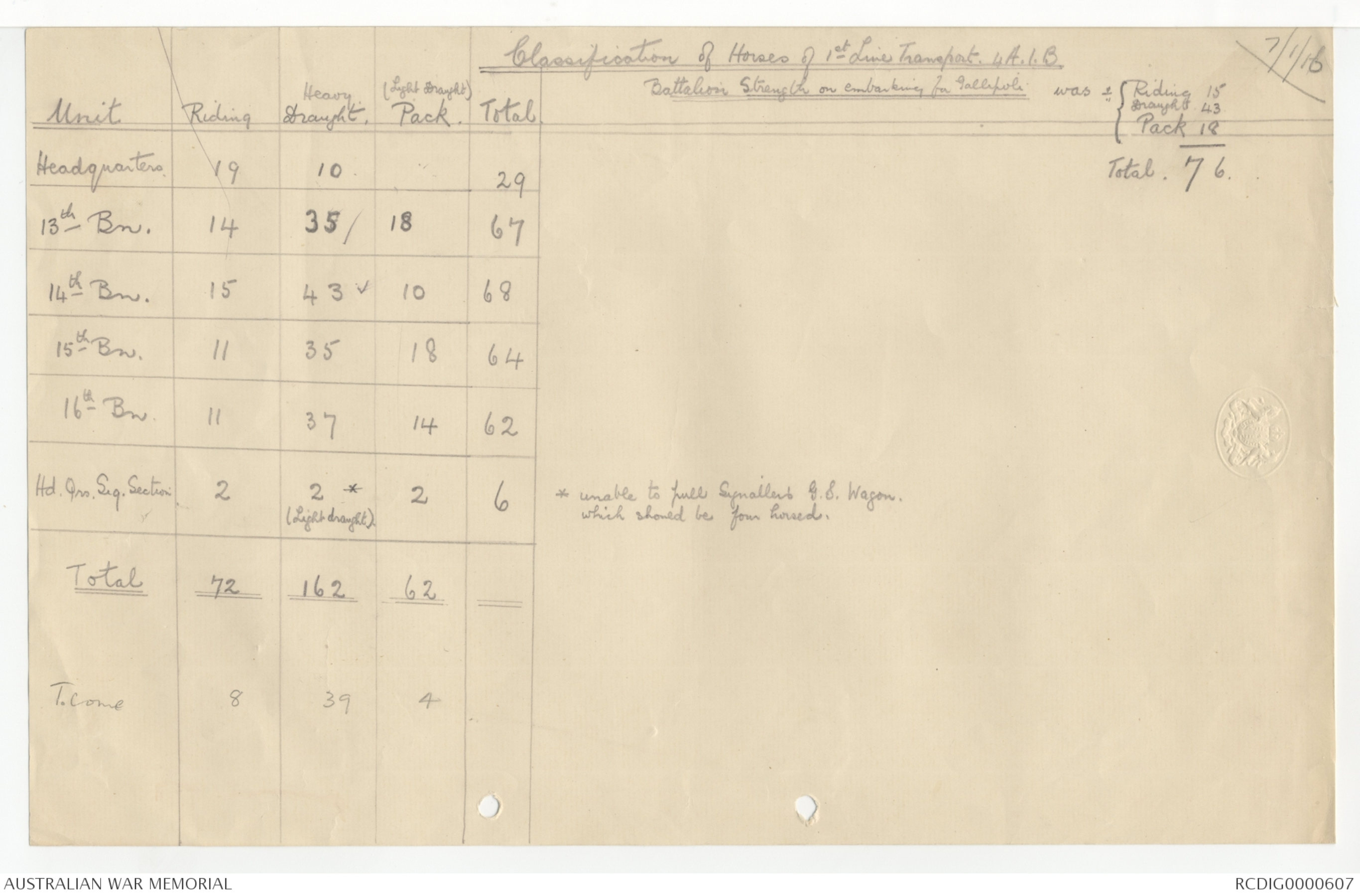
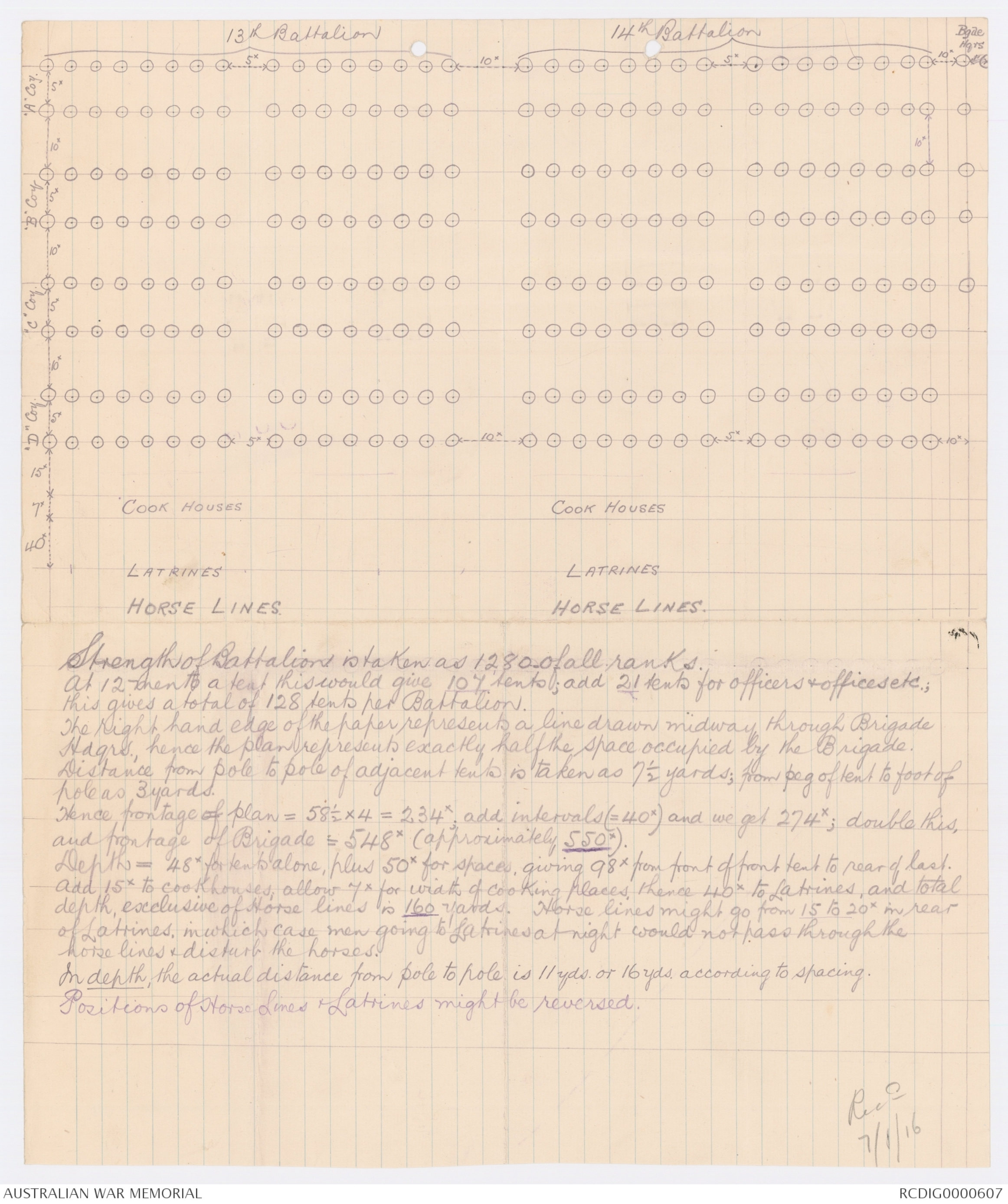
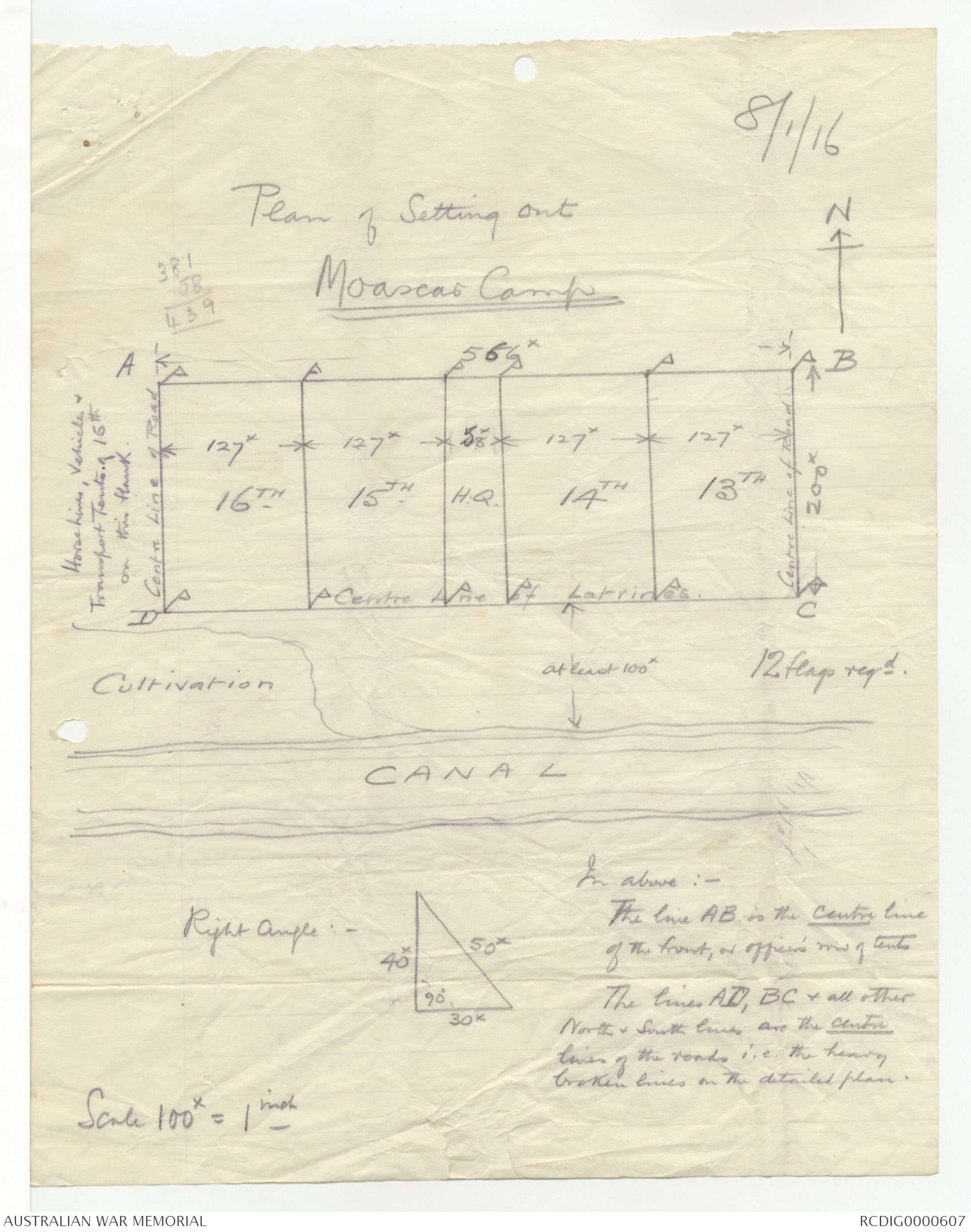
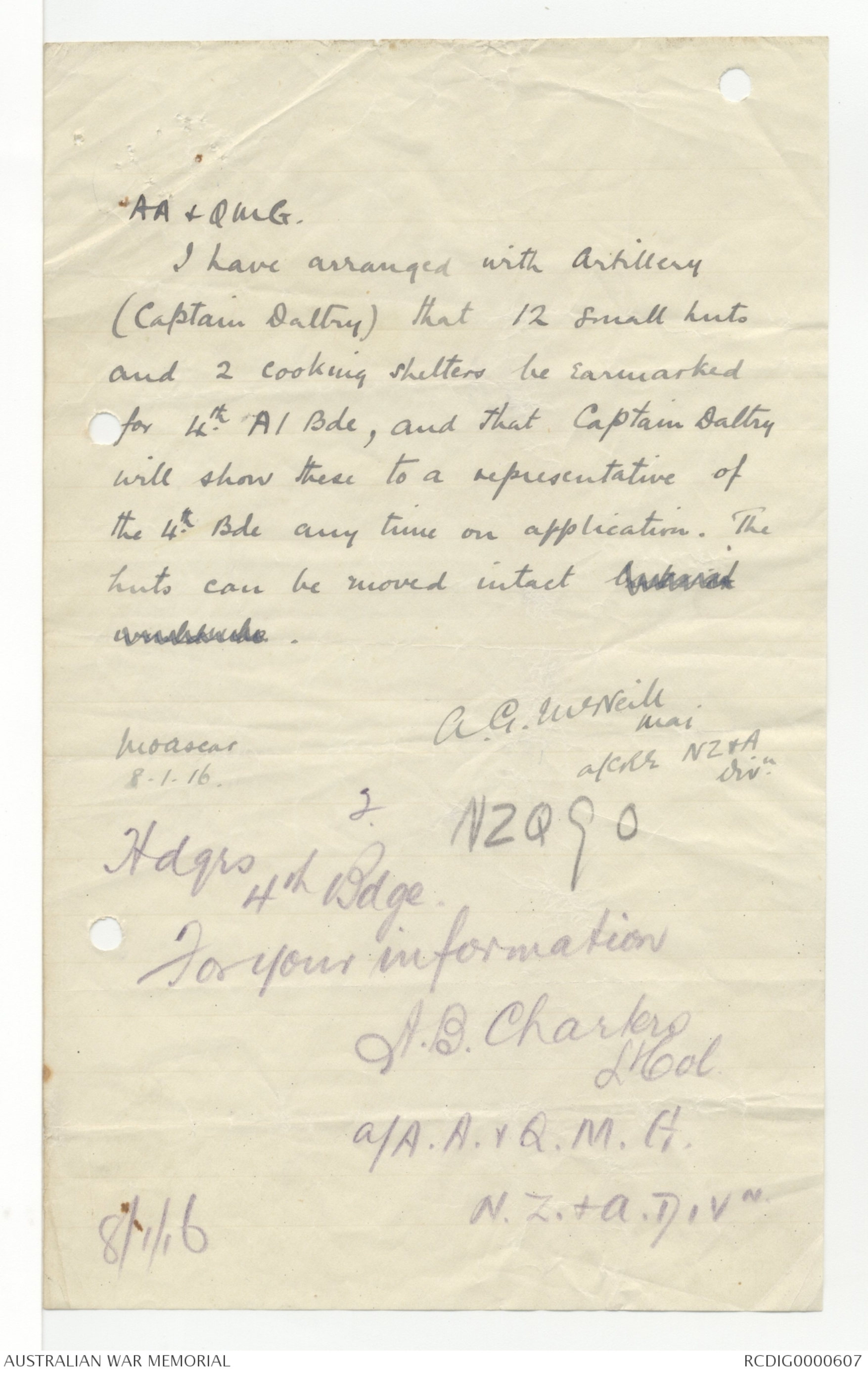
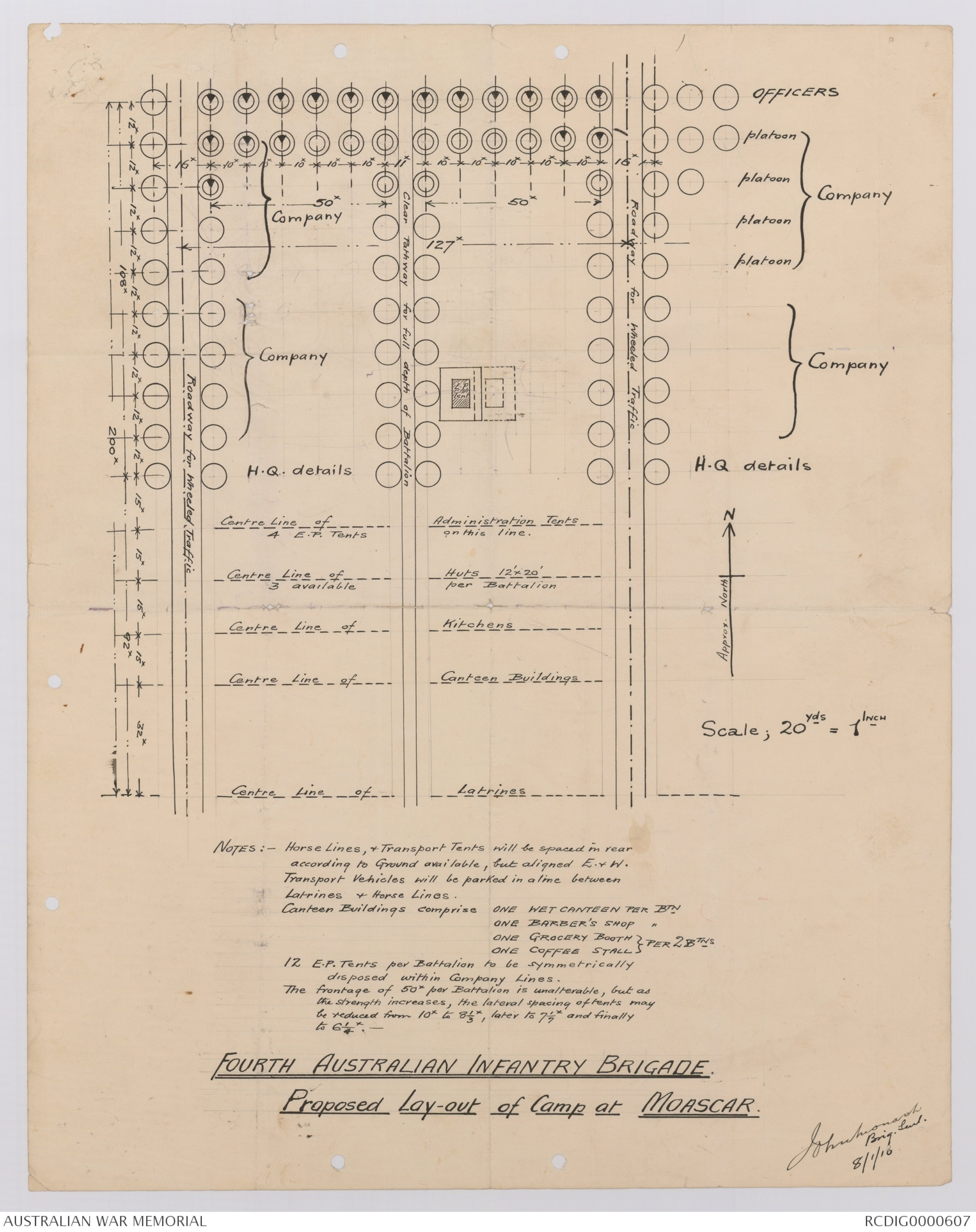
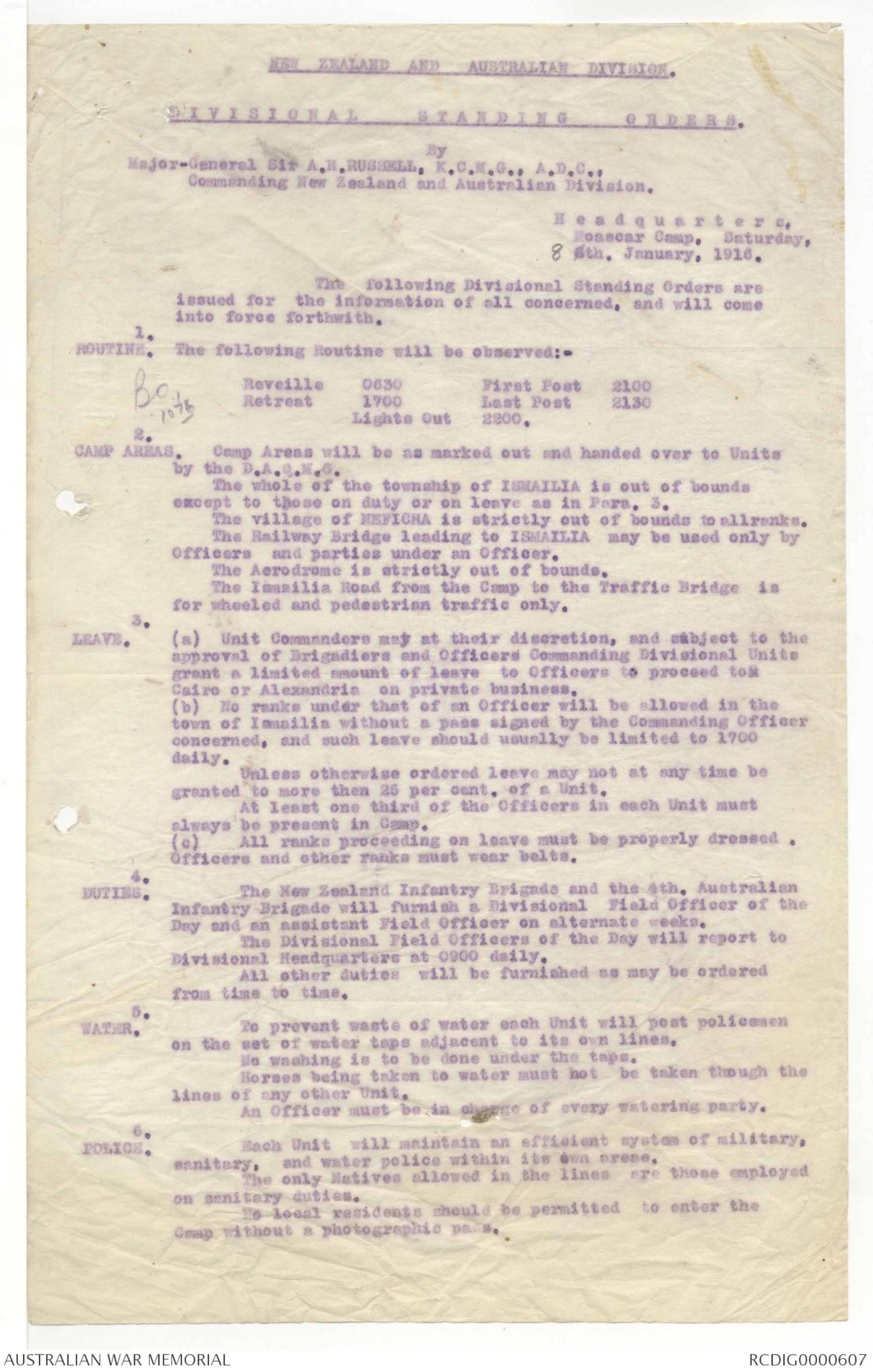
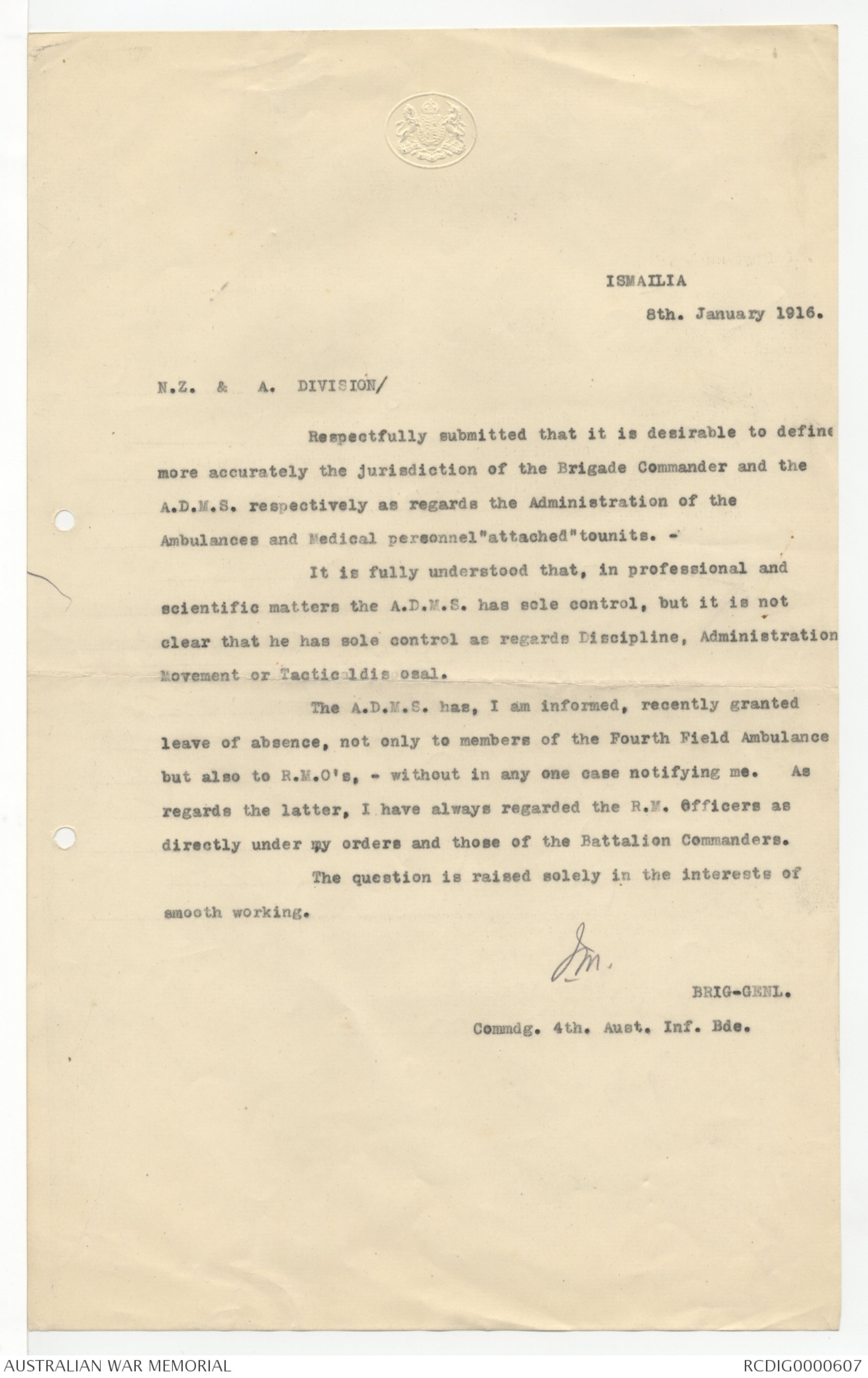
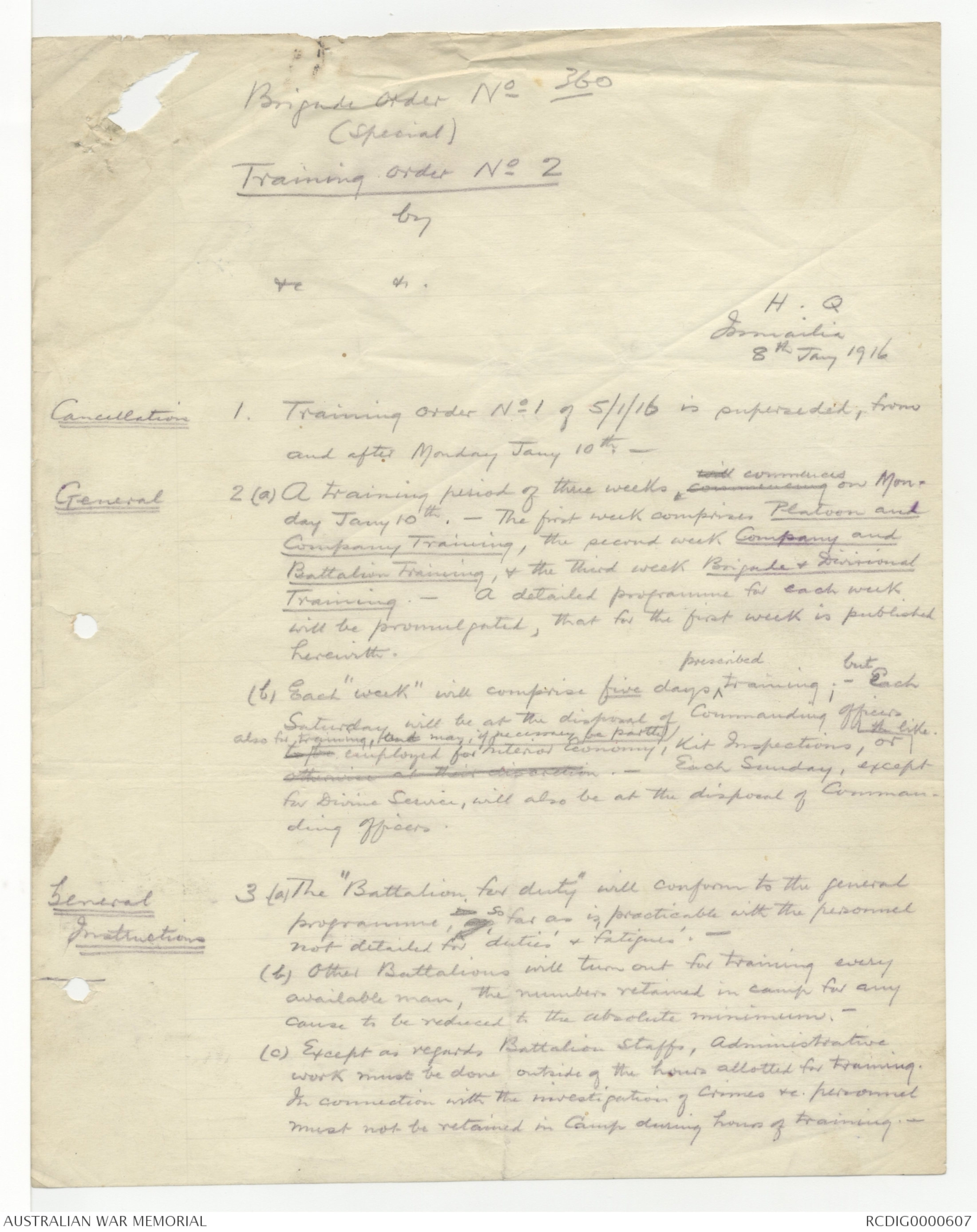
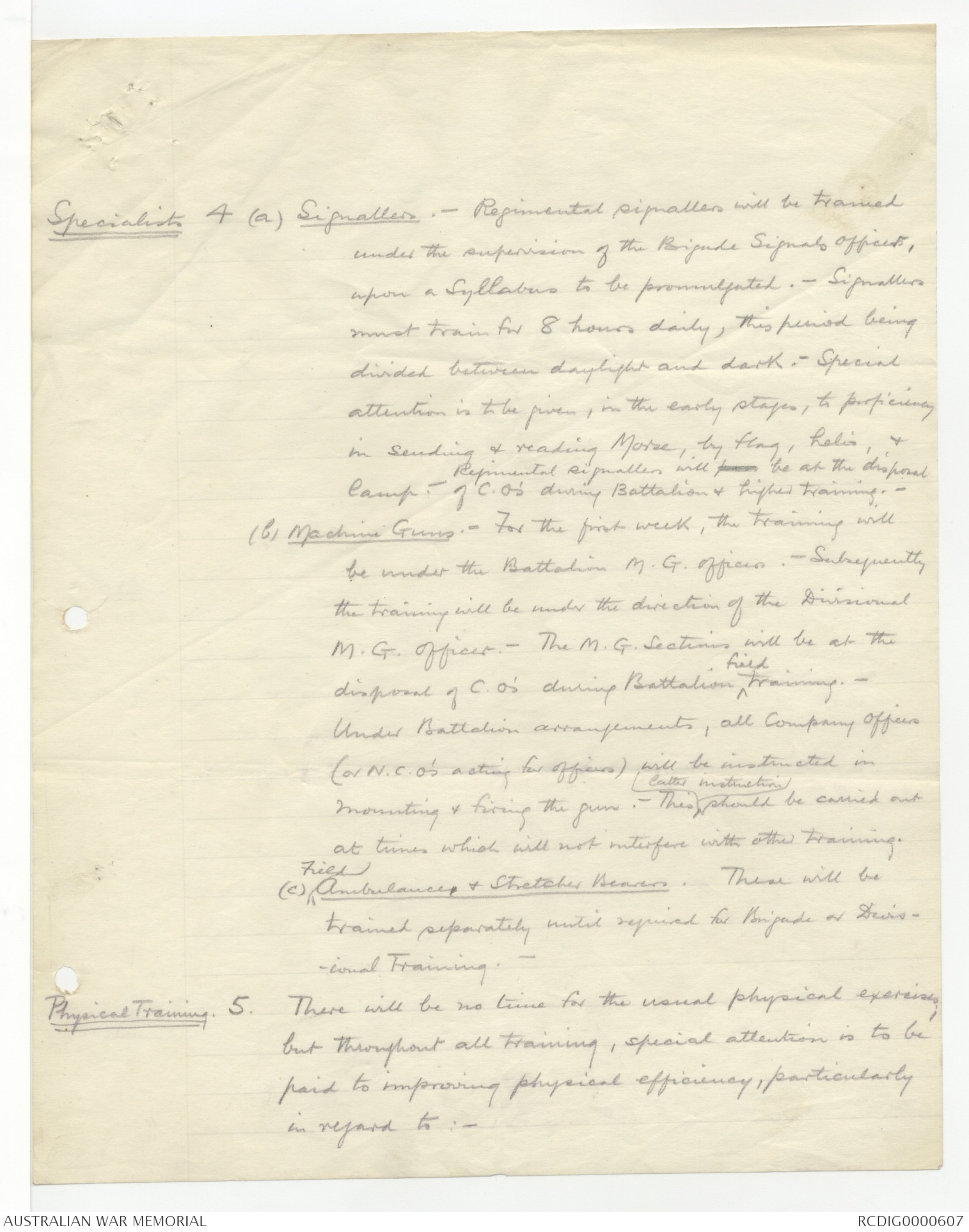
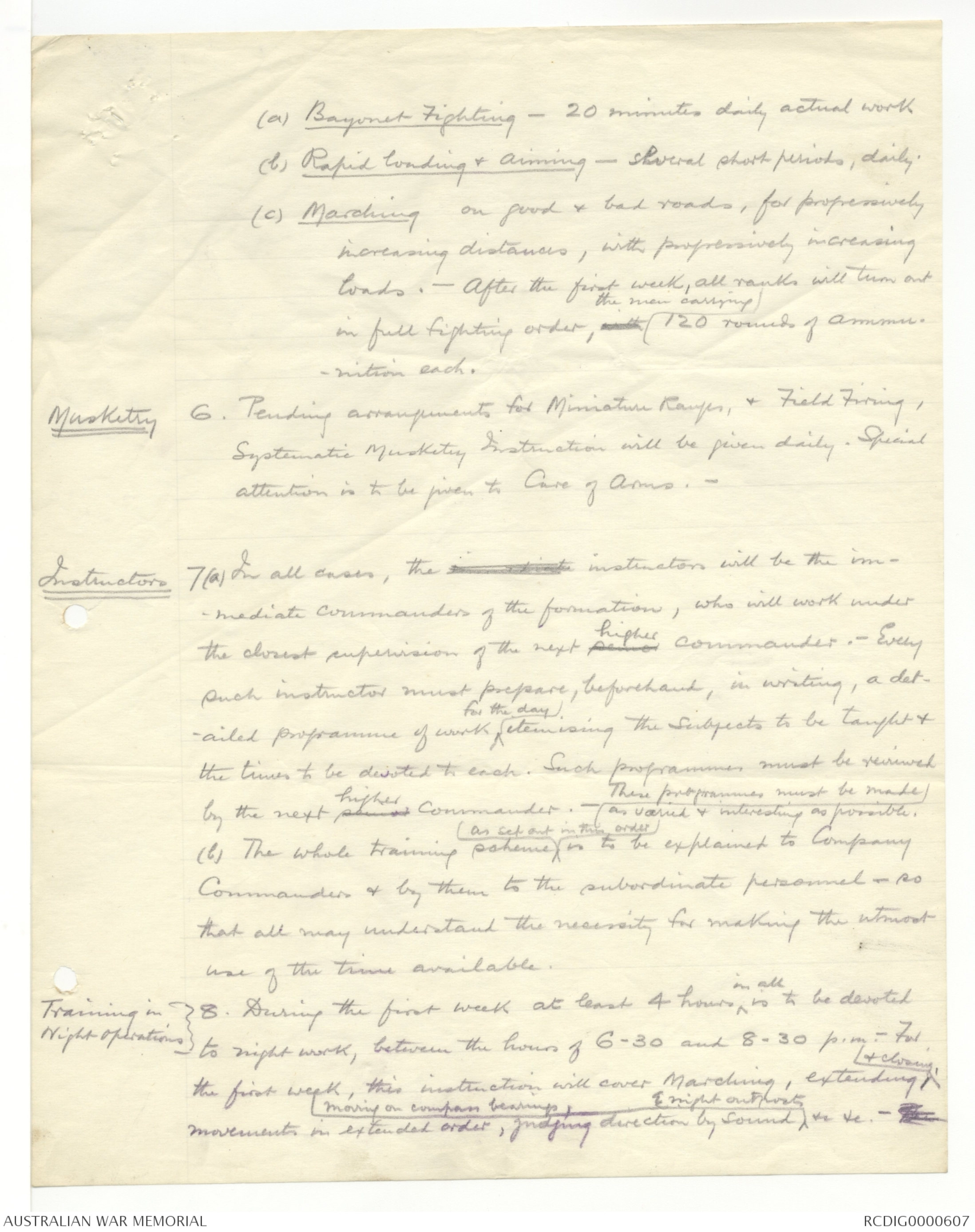
| Classification of Horses of 1st Line Transport 4 A.I.B. 7/1/16 | |||||
| Battalion Strength on embarking for Gallipoli | |||||
| Unit | Riding | Heavy Draught. |
(Lightdraught) Pack. |
Total |
was: {Riding 15 {Draught 43 {Pack 18 Total. 76 |
| Headquarters | 19 | 10 | 29 | ||
| 13th Bn. | 14 | 35 | 18 | 67 | |
| 14th Bn. | 15 | 43 | 10 | 68 | |
| 15th Bn. | 11 | 35 | 18 | 64 | |
| 16th Bn. | 11 | 37 | 14 | 62 | |
| Hd Qrs. Sig. Section | 2 |
2* (Lightdraught) |
2 | 6 | *unable to pull Signallers G.S. Wagon which should be four horsed. |
|
Total
T.come |
72
8 |
162
39 |
62
4 |
||
[Hand drawn diagram, see original]
Strength of Battalion is taken as 1280 of all ranks.
At 12 men to a tent this would give 107 tents; add 21 tents for officers & offices etc;
this gives a total of 128 tents per Battalion.
The right hand edge of the paper represents a line drawn midway through Brigade
Hdqrs, hence the plan represents exactly half the space occupied by the Brigade.
Distance from pole to pole of adjacent tents is taken as 7½ yards; from peg of tent to foot of
pole as 3 yards.
Hence frontage of plan = 58½ x4 = 234x; add intervals (=40x) and we get 274x ; double this,
and frontage of Brigade = 548x (approximately 550x).
Depth = 48x for tents alone, plus 50x for spaces, giving 98x from front of front tent to rear of last.
Add 15x to cookhouses, allow 7x for width of cooking places, thence 40x to Latrines, and total
depth, exclusive of Horse lines is 160 yards. Horse lines might go from 15 to 20x in rear
of Latrines, in which case men going to Latrines at night would not pass through the
horse lines & disturb the horses.
In depth, the actual distance from pole to pole is 11 yds. or 16 yds. according to spacing.
Positions of Horse Lines & Latrines might be reversed.
Recd
7/1/16
8/1/16
Plan of Setting out
Moascar Camp
[*381
58
____
439*]
[Hand drawn diagram, see original]
[Hand drawn diagram, see original]
In above:-
The line AB is the Centre line
of the front, or officers row of tents
The lines AD, BC & all other
North & South lines are the Centre
lines of the roads i.e. the heavy
broken lines on the detailed plan.
AA & QMG.
I have arranged with Artillery
(Captain Daltry) that 12 small huts
and 2 cooking shelters be earmarked
for 4th AI Bde, and that Captain Daltry
will show these to a representative of
the 4th Bde any time on application. The
huts can be moved intact behindxxxxxxx .
A. G. McNeill
Maj
a/Cdr NZ & A
Divn
Moascar
8.1.16.
2.
NZQ90
Hdqrs
4th Bdge.
For your information
A.B. Charters
Lt Col
a/A. A. & Q.M.G.
N.Z. & A.Divn
8/1/16
[Hand drawn diagram, see original]
NOTES:- Horse Lines, & Transport Tents will be spaced in rear
according to Ground available, but aligned E. & W.
Transport Vehicles will be parked in a line between
Latrines & Horse Lines.
Canteen Buildings comprise ONE WET CANTEEN PER BTN
ONE BARBER'S SHOP " "
ONE GROCERY BOOTH ) PER 2 BNS
ONE COFFEE STALL ) " "
12 E.P. Tents per Battalion to be symmetrically
disposed within Company Lines.
The frontage of 50x per Battalion is unalterable, but as
the strength increases, the lateral spacing of tents may
be reduced from 10x to 81/3x, later to 71/7x and finally
to 6¼x. -
FOURTH AUSTRALIAN INFANTRY BRIGADE.
Proposed Lay-out of Camp at MOASCAR.
John Monash
Brig. Genl.
8/1/16
NEW ZEALAND AND AUSTRALIAN DIVISION.
D I V I S I O N A L S T A N D I N G O R D E R S.
By
Major-General Sir A.H.RUSSELL, K.C.M.G., A.D.C.,
Commanding New Zealand and Australian Division.
H e a d q u a r t e r s,
Moascar Camp, Saturday,
8 6 th. January, 1916.
The following Divisional Standing Orders are
issued for the information of all concerned, and will come
into force forthwith.
1.
ROUTINE. The following Routine will be observed:-
Reveille 0630 First Post 2100
Retreat 1700 Last Post 2130
Lights out 2200.
[*BO,
1076*]
2.
CAMP AREAS. Camp Areas will be as marked out and handed over to Units
by the D.A.Q.M.G.
The whole of the township of ISMAILIA is out of bounds
except to those on duty or on leave as in Para. 3.
The village of NEFISHA is strictly out of bounds to allranks.
The Railway Bridge leading to ISMAILIA may be used only by
Officers and parties under an Officer.
The Aerodrome is strictly out of bounds.
The Ismailia Road from the Camp to the Traffic Bridge is
for wheeled and pedestrian traffic only.
3.
LEAVE. (a) Unit Commanders may at their discretion, and subject to the
approval of Brigadiers and Offfcers Commanding Divisional Units
grant a limited amount of leave to Officers to proceed ton
Cairo or Alexandria on private business.
(b) No ranks under that of an Officer will be allowed in the
town of Ismailia without a pass signed by the Commanding Officer
concerned, and such leave should usually be limited to 1700
daily.
Unless otherwise ordered leave may not at any time be
granted to more than 25 per cent. of a Unit.
At least one third of the Officers in each Unit must
always be present in Camp.
(c) All ranks proceeding on leave must be properly dressed.
Officers and other ranks must wear belts.
4.
DUTIES. The New Zealand Infantry Brigade and the 4th. Australian
Infantry Brigade will furnish a Divisional Field Officer of the
Day and an assistant Field Officer on alternate weeks.
The Divisional Field Officers of the Day will report to
Divisional Headquarters at 0900 daily.
All other duties will be furnished as may be ordered
from time to time.
5.
WATER. To prevent waste of water each Unit will post policemen
on the set of water taps adjacent to its own lines.
No washing is to to be done under the taps.
Horses being taken to water must not be taken through the
lines of any other Unit.
An Officer must be in charge of every watering party.
6.
POLICE. Each Unit will maintain an efficient system of military,
sanitary, and water police within its own areas.
The only Natives allowed in the lines are those employed
on sanitary duties.
No local residents should be permitted to enter the
Camp without a photographic pass.
ISMAILIA
8th. January 1916.
N.Z. & A. DIVISION/
Respectfully submitted that it is desirable to define
more accurately the jurisdiction of the Brigade Commander and the
A.D.M.S. respectively as regards the Administration of the
Ambulances and Medical personnel "attached" tounits.-
It is fully understood that, in professional and
scientific matters the A.D.M.S. has sole control, but it is not
clear that he has sole control as regards Discipline, Administration,
Movement or Tactical disposal.
The A.D.M.S. has, I am informed, recently granted
leave of absence, not only to members of the Fourth Field Ambulance
but also to R.M.O's, - without in any one case notifying me. As
regards the latter, I have always regarded the R.M. Officers as
directly under my orders and those of the Battalion Commanders.
The question is raised solely in the interests of
smooth working.
JM
BRIG-GENL.
Commdg. 4th. Aust. Inf. Bde.
Brigade Order No 360
(Special)
Training Order No 2
by
&c &c
H.Q
Ismailia
8th Jany 1916
Cancellation 1. Training Order No 1 of 5/1/16 is superseded, from
and after Monday Jany 10th -
General 2. (a) A training period of three weeks, will xommencing commenced on Monday
Jany 10th . - The first week comprises Platoon and
Company Training, the second week Company and
Battalion Training, & the Third week Brigade & Divisional
Training - A detailed programme for each week
will be promulgated, that for the first week is published
herewith.
(b) Each "week" will comprise five days, ^prescribed training; - ^but Each
Saturday will be at the disposal of Commanding officers
also for training, and may, if necessary be partlyto thr employed for interior Economy, Kit Inspections, or ^the like.otherwise at their disposation. - Each Sunday, except
for Divine Service, will also be at the disposal of Commanding
officers.
General
Instructions 3. (a) The "Battalion for duty" will conform to the general
programme, in go so far as is, practicable with the personnel
not detailed for 'duties' & 'fatigues'. -
(b) Other Battalions will turn out for training every
available man, the numbers retained in camp for any
cause to be reduced to the absolute minimum. -
(c) Except as regards Battalion Staffs, Administrative
work must be done outside of the hours allotted for training.
In connection with the investigation of Crimes &c personnel
must not be retained in Camp during hours of training. -
Specialists 4.(a) Signallers. - Regimental signallers will be trained
under the supervision of the Brigade Signals Officer,
upon a Syllabus to be promulgated. - Signallers
must train for 8 hours daily, this period being
divided between daylight and dark. - Special
attention is to be given, in the early stages, to proficiency
in sending & reading Morse, by flag, helio, &
lamp. - Regimental signallers will xxxx be at the disposal
of C.O's during Battalion & higher training.-
(b) Machine Guns. - For the first week, the training will
be under the Battalion M. G. officers. - Subsequently
the training will be under the direction of the Divisional
M. G. Officer. - The M.G. Sections will be at the
disposal of C.O's during Battalion ∧ field training. -
Under Battalion arrangements, all Company Officers
(or N.C.O's acting for officers) will be instructed in
mounting & firing the gun. - This ^latter instruction should be carried out
at times which will not interfere with other training.
(c) Field Ambulance & Stretcher Bearers. These will be
trained separately until required for Brigade or Divisional
Training. -
Physical Training 5. There will be no time for the usual physical exercises,
but throughout all training, special attention is to be
paid to improving physical efficiency, particularly
in regard to:-
(a) Bayonet Fighting – 20 minutes daily actual work.
(b) Rapid Loading & Aiming – several short periods, daily.
(c) Marching on good & bad roads, for progressively
increasing distances, with progressively increasing
loads. - After the first week, all ranks will turn out
in full fighting order, with the men carrying 120 rounds of ammunition
each.
Musketry 6. Pending arrangements for Miniature Ranges, & Field Firing,
Systematic Musketry Instruction will be given daily. Special
attention is to be given to Care of Arms. -
Instructors 7. (a) In all cases, the xxxxx instructors will be the immediate
commanders of the formation, who will work under
the closest supervision of the next senior higher Commander, - Every
such instructor must prepare, beforehand, in writing, a det
ailed programme of work ^for the day, itemising the subjects to be taught &
the times to be devoted to each. Such programmes must be reviewed
by the next senior higher Commander. - These programmes must be made
as varied & interesting as possible.
(b) The whole training scheme, ∧as set out in this order is to be explained to Company
Commanders & by them to the subordinate personnel - so
that all may understand the necessity for making the utmost
use of the time available.
Training in Night operations 8. During the first week at least 4 hours ^in all is to be devoted
to night work, between the hours of 6-30 and 8-30 p.m. - For
the first week, this instruction will cover Marching, extending ^& closing,
movements in extended order, judging direction by sound,
^moving on compass bearings & night outposts etc etc. - The
 Daphne
DaphneThis transcription item is now locked to you for editing. To release the lock either Save your changes or Cancel.
This lock will be automatically released after 60 minutes of inactivity.